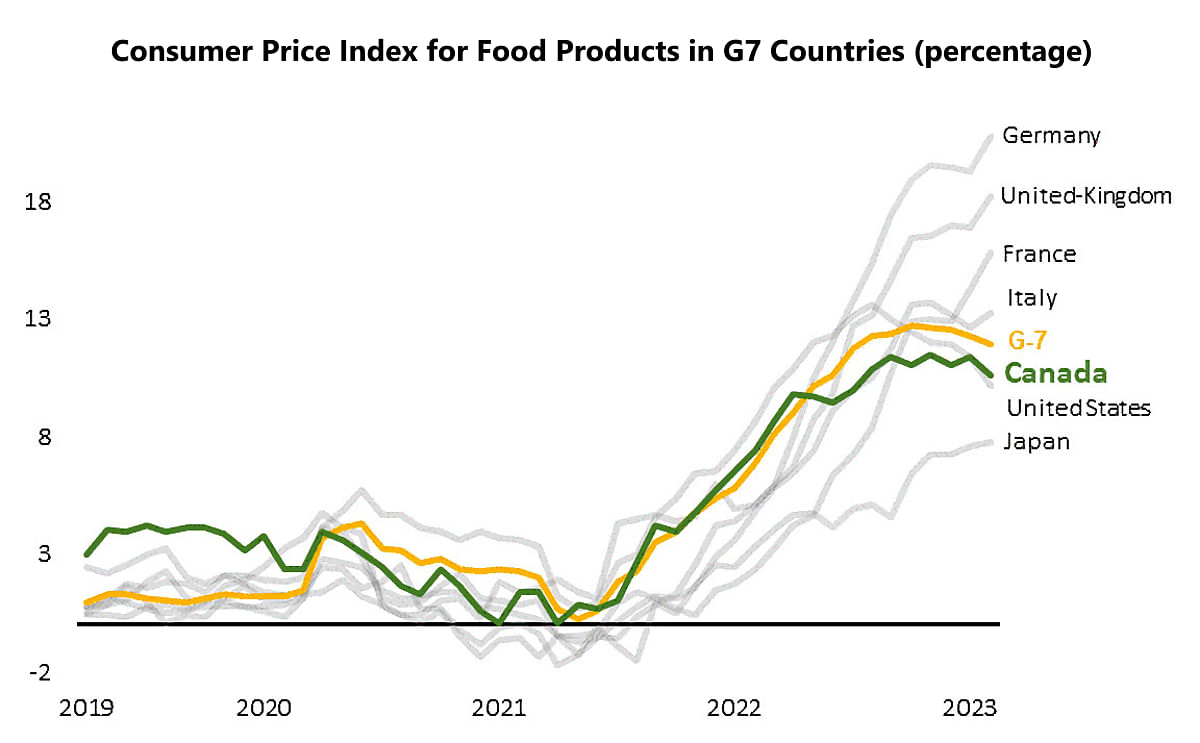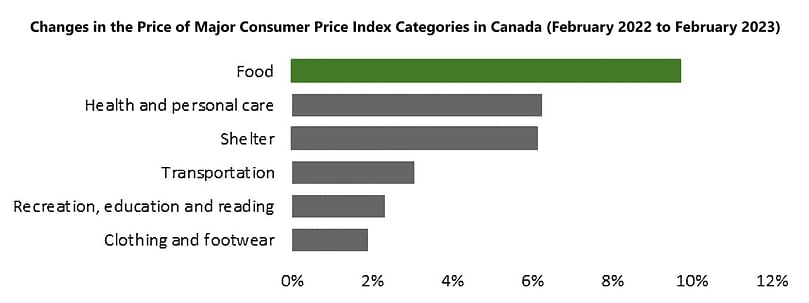Consumer Price Index for Food Products in G7 Countries (percentage)
Rise of Food Prices in Canada Significant but Still Less than in Other Countries, Says a Canadian Parliament Committee Report

In September 2022, there was a significant increase in the price of food bought from stores in Canada. The Consumer Price Index (CPI) reported a year-over-year increase of 11.4%, marking the largest acceleration since 1981.
This surge in food prices surpassed the average inflation rate of 6.9% in the Canadian economy during the same period. Despite the overall inflation rate slowing down in February 2023, consumer food prices remained high, with a double-digit year-over-year increase in this category for seven consecutive months.
This increase in food prices is the result of a ripple effect throughout the supply chain. Farmers and producers experienced sharp rises in the prices of essential inputs like feed, fuel, and fertilizer, leading to a 16.1% increase in their operating expenses.
Small and medium-sized food processors, who constitute a significant portion of the sector, faced challenges such as higher prices for transport and packaging materials, as well as ongoing labor shortages and supply chain disruptions.
The food retail sector serves as the crucial intermediary between producers and consumers. Canadians predominantly purchase their food from stores, making them a vital marketplace for agri-food producers.
While the food and beverage retail sector faced similar cost pressures due to supply chain issues and labor shortages, they also saw an increase in net income. Their net income peaked at CAD 1.8 billion (USD 1.35 billion) in the first quarter of 2021 and has remained above CAD 1 billion (USD 754 million).
The sector reported an average profit margin of 2.87% in the fourth quarter of 2022, compared to 1.57% in the same period in 2019. These figures have raised concerns among consumer groups and stakeholders about how increasing costs are being distributed along the supply chain.
Some have even speculated about whether the five largest retailers, controlling 80% of the grocery market, are engaging in "price-gouging" by raising prices faster than their production costs.
Recognizing the extraordinary nature of these price increases and their impact on various stakeholders, the House of Commons Standing Committee on Agriculture and Agri-Food initiated a study on inflation in the food supply chain and the rising cost of groceries.
The Committee conducted eight meetings between December 2022 and April 2023, hearing from 58 witnesses representing primary producers, food processors, food retailers, and civil society groups.
The Committee's report summarizes their findings and proposes recommendations to the Government of Canada to address the effects of inflationary pressures across the supply chain, particularly on producers, consumers, and communities.
During the discussions, it was highlighted by several witnesses that food prices have been rising globally. Jodat Hussain, Senior Vice President of Retail Finance at Loblaw Companies Limited, noted that Canada is in a relatively better position compared to the United States.
He stated that since the second quarter of 2020, Canadian food price inflation has not been higher than that of the U.S. Witnesses emphasized that Canada has been less affected by food inflation compared to its main trading partners.
Data from the Organisation for Economic Co-operation and Development (OECD) supported this perspective. As of January 2023, Canada's food inflation rate was lower than the average rates in Germany, the United Kingdom, and France, and it was comparable to the rate in the United States.
The report illustrates the inflation rates for food products among G7 countries, providing a visual representation of the different rates. These comparisons highlight that while food prices have been increasing in Canada, the country has fared relatively well compared to its counterparts.
The testimony and data suggest that other nations have experienced higher levels of food inflation. However, it is essential to note that this information pertains to a specific timeframe and may be subject to change as global economic conditions evolve.

Changes in the Price of Major Consumer Price Index Categories in Canada (February 2022 to February 2023)
The Committee proposed several recommendations to enhance the Competition Bureau's role in ensuring competition within the Canadian grocery sector. These recommendations are as follows:
- Enacting legislative changes to the Competition Act: The Government of Canada should introduce amendments to the Competition Act, granting the Competition Bureau the authority to compel companies and individuals under investigation in its market studies to provide relevant documents and information, including detailed financial data.
- Reviewing competitive thresholds for mergers and acquisitions: The competitive thresholds used by the Competition Bureau to assess mergers and acquisitions should be reviewed to ensure that competition in the grocery sector is not compromised. This evaluation aims to safeguard a competitive market environment.
- Exploring the establishment of a permanent administrative commission: The possibility of establishing a permanent administrative commission, similar to France's Observatoire de la formation des prix et des marges des produits alimentaires (Observatory of the formation of prices and margins of food products), should be studied. This commission would be tasked with analyzing data pertaining to price formation and profit margins throughout the agri-food supply chain.
Considering recommendations from the Competition Bureau's market study: The federal government should carefully consider any conclusions and recommendations presented by the Competition Bureau in its forthcoming market study on the Canadian grocery sector.
Key areas of focus include price-setting mechanisms, "black-out" periods, revenue sharing within the agri-food chain, and the barriers faced by new entrants to the sector.
By implementing these recommendations, the Committee believes that the Government of Canada can strengthen the Competition Bureau's mandate and capabilities in promoting fair competition and addressing concerns within the grocery industry.








